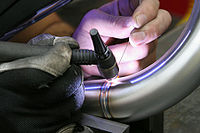Stainless Steel Welding
Stainless Steel Welding may not be as difficult as welding aluminum, the metal does have its specific properties that vary from your more common steels.
To make a steel "stainless" it needs to contain a minimum of 12% Chromium (Cr). The Cr oxidises in the atmosphere forming a passive layer on the surface. This layer, unlike coated steels, is self repairing should it be scratched.
The problem with 12% Cr is that it is fairly brittle and only provides the minimum corrosion resistance. Increasing the Chromium content to 17% improves corrosion resistance but increases brittleness. Adding 8% Nickel makes the steel ductile again. Thus 18/8 stainless was born (304). 316 / 316L has additional Molybdenum and higher Nickel which provides greater corrosion resistance.
With stainless when you see two numbers they always refer to the Chromium and Nickel content - 18/8 is 18%Cr and 8%Ni. If you see 3 numbers like 19/12/3 they refer to the Chromium, Nickel and Molybdenum content. 316L is 19%Cr, 12%Ni and 3%Mo.
The usual choice for the filler when welding stainless to mild is 309L. 309 is over alloyed stainless steel (19/10) so when diluted by the mild steel gives a deposit approximately like 308L / 304L.
There are other fillers that give a crack free weld, 312, 308MoL, 307 and 310 will all work but these are less widely available than 309L.
Videos
